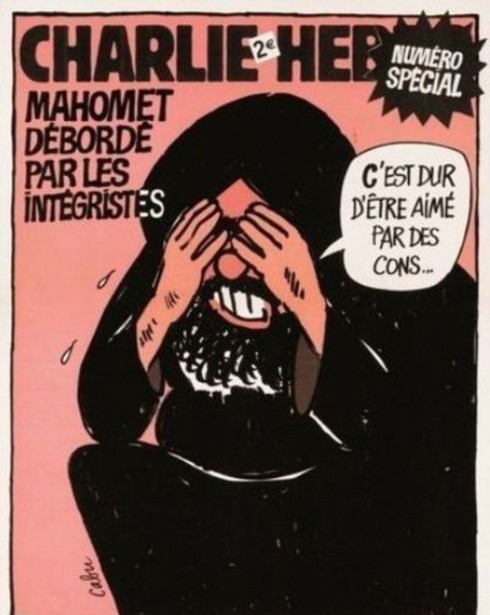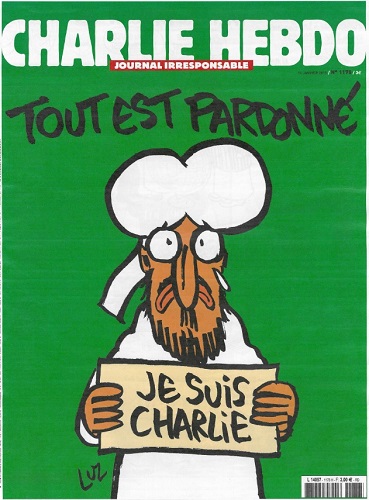Charlie Hebdo Cartoons: Respectful of Muhammad
David Rand, 2015-01-24
Ever since the odious terrorist attack against the editorial staff of Charlie Hebdo on January 7th 2015, we have been told repeatedly that the cartoons published in that magazine are offensive, vulgar, provocative, etc. Is that really the case?
The cartoonists of Charlie Hebdo had and continue to have a reputation for producing drawings that shock. This is sometimes true, but it is far from always the case. In particular, the depictions of Muhammad in the magazine reflect on the contrary a very human and often friendly image, even a flattering one.

(1) A Muhammad outraged by the barbarity of
fundamentalists.
“Muhammad overwhelmed by fundamentalists”
He says, “It isn’t easy being liked by idiots…”
But before I explain, I must emphasize that my purpose here is not to claim that these artists were and are “innocent” of producing offensive cartoons, as if to do so were a crime deserving of murderous repression. They are neither innocent nor guilty because blasphemy is not a crime in France and should not be one anywhere. There is absolutely nothing that could possibly justify the fate of the victims of this attack. The massacre was an atrocity; a religious, Islamic, Muslim atrocity perpetrated in the name of Islam; anyone who denies that must be morally and intellectually bankrupt. Of course this obvious fact does not imply that all Muslims are guilty of it. Kindly refrain from spurious accusations that I am painting all Muslims with the same brush.
Instead, my goal is to set the record straight regarding the nature of the controversial cartoons, i.e. whether and why they might be considered shocking. Or not. At the same time, I will explain how the refusal of many media to publish the cartoons is even more cowardly than one might think.

(2) A saddened and compassionate
Muhammad. — “All is forgiven”
Consider, then, the five cartoons that accompany this article. They are not a complete set of all depictions of Muhammad ever published in the magazine. Rather they constitute a sample, indeed a fairly representative sample because they include what are arguably the two most important and famous of all, namely (1) published on February 8th 2006 during the Danish cartoon controversy and (2) the cover of the first issue of the magazine following the attack.

(3) A jovial and good-natured Muhammad.
“100 lashes if you don’t die laughing!”
Cartoon (1) depicts a Muhammad outraged by the barbarity of fundamentalists. Cartoon (2) shows a saddened and compassionate Muhammad. In cartoon (3) he is a jovial, good-natured chap while the Muhammad of cartoon (4) suffers as victim of fundamentalist barbarity. Only in the last cartoon, number (5), do we find a Muhammad who is clearly the brunt of mockery, an aspect which is absent from the first four. But in reality, the fifth drawing is less a parody of Muhammad than a parody of Brigitte Bardot in the cult film “Le Mépris” (“Contempt” 1963) by Jean-Luc Godard.
Overall, these cartoons convey an image of Muhammad which is resolutely human, with virtues and faults that any human could have, but mainly virtues. In fact, it is through this character of Muhammad that the cartoonists of Charlie Hebdo convey their own values: their categorical rejection of fundamentalist fanaticism and their compassion for its victims. In order to be offended by cartoons (1) through (4), one would have to be either a fundamentalist or suffering from an extremely unhealthy hypersensitivity.
In order to justify the anger that these cartoons seem to trigger, we are told that, for Muslims, any depiction of the “prophet” is blasphemous. However:
- This is not necessarily the belief in all currents of Islam. In the history of Islam, Muhammad’s countenance has sometimes been depicted. At any rate, it is idolatry, i.e. the worship of images and sculptures of humans and animals, that is in fact prohibited.
- As Pierre Bayle (1647-1706) pointed out, “Blasphemy is scandalous only in the eyes of one who worships the reality being blasphemed.” But the cartoonists of Charlie Hebdo are not Muslims as far as I know. Thus, this ban, if it exists, would not apply to them. To impose it amounts to applying the rules of a religion to persons who are not adherents of that religion. It is thus a blatant violation of their freedom of conscience.
- At any rate, Muslim theology’s insistence on the prohibition of idolatry and on the absolute uniqueness of the god “Allah” imply that it would be blasphemous to require that a human being – even a prophet – be revered as god incarnate, as Christians do with their Jesus. Thus, the fundamentalists who venerate Muhammad to the point of deifying him and who vilify Charlie Hebdo for humanizing him would be guilty of blasphemy, not the cartoonists!

(4) A Muhammad victim of fundamentalist barbarity.
“If Muhammad were to return…”
He says, “I am the prophet, you idiot!”
The other replies, “Shut up infidel!”
One might even consider these cartoons to be too respectful of Muhammad, that is to say, that the rather positive image they convey is not entirely compatible with the many suras of the koran which present him more as a warrior.
Is my interpretation of these cartoons biased and personal? I am not alone in my appreciation. According to columnist Hussein Ibish of the website Now Lebanon, the cover (2) is in no way disrespectful but rather it is “brave,” “touching,” “generous” and “magnanimous.” If the individual depicted really is Muhammad – Ibish is not totally convinced that it is – then the image conveyed by the Charlie Hebdo cartoon – and not for the first time – proves “more humane and decent than some of his followers, particularly violent extremists.”
The meaning of any cartoon is indeed open to interpretation. That is why is it so important that any interested individual be able to view the image, so that one can judge for oneself just what is going on.

(5) For once, a Muhammad who is clearly
a target of mockery (and a parody of
Brigitte Bardot in the film “Le Mépris”).
“The film which is taking the Muslim world
by storm” — Muhammad says
“And my buttocks, do you like my buttocks?”
But that was not the case for large sections of the public. In Canada, several French-language newspapers, especially in Quebec, published the first cartoon on January 8th in memory of victims of the attack. But the English-language media in Canada, with the exception of one Toronto newspaper (National Post), decided not to publish it, thus displaying miserable cowardice. As a result, millions of readers of these media were deprived of essential information necessary to comprehend the situation. The media simply repeated the usual mantra that Charlie Hebdo cartoons are “offensive” or “provocative” and readers had no choice but to accept this allegation blindly. Readers nevertheless had the choice of searching for them on the internet, but what proportion would actually take the initiative to do so?
A similar situation occurred in 2006 when everyone was commenting on the infamous Danish cartoons while most of the media refused to publish them. How can one judge a cartoon without seeing it?
In the so-called Muslim world, the situation is even worse. Almost all major media decided not to publish the cover (2), thus depriving hundreds of millions of readers of essential information, while religious authorities declared the images blasphemous. Once again, the public is instructed on what to think but denied access to the means to inform themselves directly. We need not be astonished that many obey and, out of a sense of religious obligation, declare themselves to be duly “offended.” This reeks of manipulation, using religion as a tool for political purposes. One is reminded of the controversy surrounding the Danish cartoons, when it was revealed that new intentionally provocative cartoons had been added to the collection by Muslims in order to stir up hatred against the cartoonists.
As atheists, and thus rationalists, confident in the individual’s ability to practice free criticism, we do not hesitate to analyze objectively that which is put before us, rather than following the trend of demonizing that which others would hide from us. To judge the cartoons, the best approach is to display them and expose them to critical scrutiny, which is exactly the opposite of the religious attitude – and we know to what obscurantism such an attitude leads. In the West, freedom of thought and the right to express it are fundamental values which everyone should be proud to exercise: to defend and assert these freedoms is a necessary consequence of respect for oneself and for one’s own dignity.
Reference
- Tout Est Pardonné, Charlie Hebdo’s latest cover isn’t objectionable; it’s brave and touching, Hussein Ibish, 2015-01-14
This article is also available as a PDF document.


 AFT on Twitter
AFT on Twitter Amis et amies de Libres penseurs athées
Amis et amies de Libres penseurs athées Atheist Alliance International (AAI)
Atheist Alliance International (AAI) Atheist Census Canada
Atheist Census Canada Humanist Perspectives
Humanist Perspectives Libres penseurs athées
Libres penseurs athées LPA-AFT on Heylo
LPA-AFT on Heylo LPA-AFT Youtube Channel
LPA-AFT Youtube Channel Rassemblement pour la laïcité (RPL)
Rassemblement pour la laïcité (RPL)
this is so nice analysis. this writing is more likely investigative report.
Thank you very much for enriching me